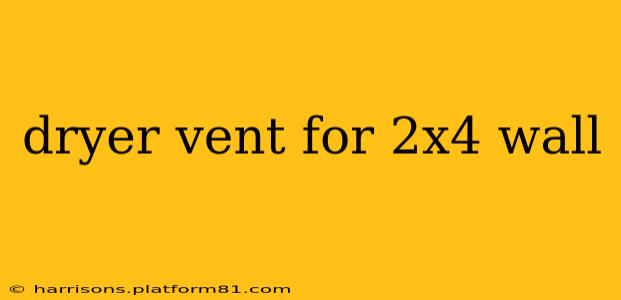Installing a dryer vent through a 2x4 wall requires careful planning and execution to ensure both safety and efficiency. Improper installation can lead to fire hazards, reduced dryer performance, and costly repairs down the line. This guide will walk you through the process, addressing common questions and concerns.
What Size Dryer Vent Do I Need for a 2x4 Wall?
The size of your dryer vent depends on the model of your dryer. Consult your dryer's owner's manual for the recommended vent diameter. Generally, 4-inch diameter vents are common, but some dryers may require a larger diameter for optimal performance. Using a vent that's too small can restrict airflow, increasing drying times and potentially causing a fire hazard. Never restrict the airflow beyond the manufacturer’s recommendation.
How Do I Cut a Hole in a 2x4 Wall for a Dryer Vent?
Cutting a hole in your wall requires precision to ensure a snug fit for your vent. Here's a step-by-step process:
- Locate the studs: Use a stud finder to precisely locate the studs in your wall. You'll want to avoid cutting through them to maintain the structural integrity of your wall.
- Mark the hole: Once you've located the studs, mark the area where you'll cut the hole, ensuring it's far enough away from the studs to avoid damage. Remember to account for the size of the vent pipe and any additional flashing required.
- Cut the hole: Use a hole saw or a jigsaw to carefully cut the hole. If using a jigsaw, use a fine-tooth blade to avoid splintering the wood. Go slow and steady to create a clean, even cut.
What Type of Dryer Vent Material Should I Use?
Rigid metal (aluminum or galvanized steel) is the preferred material for dryer vents. Flexible vents, while easier to install, can be more prone to lint buildup, which increases the risk of fire. Rigid vents allow for easier cleaning and are generally safer. Always ensure any materials you choose are compatible with your dryer and comply with local building codes.
How Do I Seal the Dryer Vent Hole?
Proper sealing is crucial to prevent air leaks and maintain energy efficiency. After installing the vent, use caulk or sealant specifically designed for exterior applications to seal around the pipe where it passes through the wall. This will prevent drafts and keep moisture out. Fire-resistant caulk is recommended for added safety.
What is the Best Way to Route a Dryer Vent Through a Wall?
The best way to route your dryer vent depends on the layout of your home. Ideally, the shortest and straightest path is preferred to minimize lint buildup. Avoid sharp bends or excessive lengths, as these can impede airflow. If necessary, use appropriate elbows and connectors designed for dryer vents. Always ensure the vent is sloped slightly downwards to prevent lint from accumulating.
Can I Use a Flexible Dryer Vent Through a 2x4 Wall?
While technically possible, rigid metal venting is highly recommended for safety reasons. Flexible vents are more prone to kinks and creases which can trap lint, leading to a fire hazard. The increased risk outweighs any convenience in installation.
What Safety Precautions Should I Take When Installing a Dryer Vent?
Safety is paramount. Always disconnect the power to the dryer before working with the vent. Wear safety glasses and gloves to protect yourself from sharp edges and debris. Carefully inspect the vent system after installation to ensure there are no obstructions or leaks. Regular cleaning of the vent is crucial to prevent lint buildup and maintain safety. Consult local building codes and fire safety regulations before starting your installation.
By following these guidelines, you can safely and efficiently install a dryer vent through your 2x4 wall. Remember, always prioritize safety and consult a professional if you are unsure about any part of the process.
